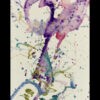O, One
a 5 minute opera
for two Nao Robots and Cello
This piece was composed as part of the Robot Opera Mini-Symposium which I organised and chaired at the University of Sussex in June 2017, with the support of the Centre for Research in Opera and Music Theatre. My colleague Professor Ed Hughes also wrote a piece for the occasion, entitled Opposite of Familiarity. Together we worked with Dr.Ron Chrisley, who patiently experimented with and programmed the Nao robots to ‘sing’ our works. We were also very much indebted to Tim Hopkins for stage direction and scenography, and were pleased to be joined by Alice Eldridge on cello and Joe Watson on piano. You can see the programme for the symposium here and documentation of the whole event here
The things we were interested in exploring were:
Robots and Performance – what happens if we put a Robot on a stage? How does an audience ‘read’ its presence? Is puppeteering the most relevant model, given the current state of embodied AI? Clearly the robot does not ‘know’ it is performing, or could you say that on some level a robot is always performing?
Embodiment – computer music has a long history involving artificial intelligence and creativity, and we already have computers that can improvise / compose / play music. If a robot is essentially a computer that can move around, how does embodiment affect or change the acquisition / expression of these skills?
Vocality – how would a robot sing if it sang like a robot rather than being programmed to sing like a human? i.e. what about its physicality would provoke / create sound? What does it ‘mean’ for a robot to sing?
In O, One I wanted to explore what it is to be a robot and the impossibility of our ever knowing that. I developed a simple libretto:
scene 1
Blue One:
I am not a robot.
Red One:
I am not singing.
scene 2
Blue One:
uuuuuuuuuuuuuuu
Red One:
me me me me me mememe me me mememe
Blue One
I i I i I i I I i i I i
them I them I them
Red One
she she she
sheeeeeeeeeee
whyiyiyiyiyiyiyiyiy?
whyiyiyiyiyiyiyiyiyi?
scene 3
Blue One
I’m going
(she stays)
Red One
I’m waiting.
(he walks off)
Knowing that deep in core of the robot there must be a lot of binary code, I translated scenes 1 and 3 into ascii binary – a series of 0’s and 1’s, and then gradually, keeping the same 8-bit rhythm, dropped human words back into the equation. So for example ‘I am not a robot’ appears like so:
O1OO1OO1,,,
O11O O O O1,
O11O11O1,,,
O11O111O,
O111O O O O,
O111O1OO,,,
O11O O O O1,,,
O111OO1O,
O11O1111,
O11OOO1O,
O11O1111,
O111O1OO,,,
(The triple commas were to make the text-to-speech programme pause longer at the end of words).
Which gradually became:
not I not not I not not I,,,
O I am not not not not I,
O I am not I am not I,,,
O I am not I I am not,
O I I am not not not not,
O I I am not I not not,,,
O I am not not not not I,,,
O I am I not not I not,
not I am not a a ro bot,
O I am not not not am not,
O I am not a ro bot I,
O I am bot not I not not,,,
Here is Blue One’s part in the first scene of the libretto. Here it is ‘performed’ by the ‘Vicki’ voice in the software ‘Isadora’, a somewhat more mature rendition than that of the Nao Robots.



